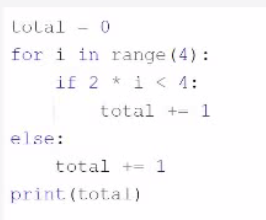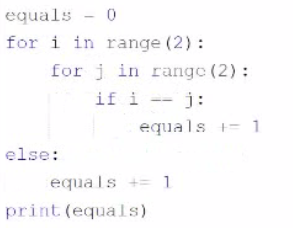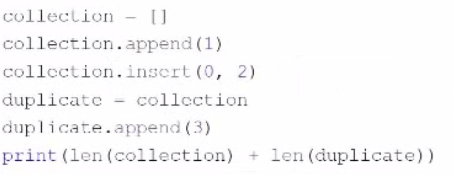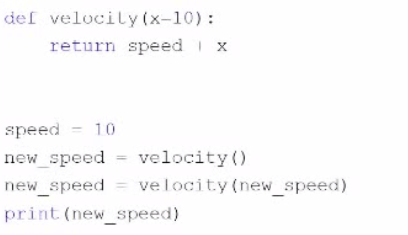Python Institute PCEP - Certified Entry-Level Python Programmer PCEP-30-02 Exam Practice Test
What happens when the user runs the following code?

Answer : B
The code snippet that you have sent is calculating the value of a variable ''total'' based on the values in the range of 0 to 3. The code is as follows:
total = 0 for i in range(0, 3): if i % 2 == 0: total = total + 1 else: total = total + 2 print(total)
The code starts with assigning the value 0 to the variable ''total''. Then, it enters a for loop that iterates over the values 0, 1, and 2 (the range function excludes the upper bound). Inside the loop, the code checks if the current value of ''i'' is even or odd using the modulo operator (%). If ''i'' is even, the code adds 1 to the value of ''total''. If ''i'' is odd, the code adds 2 to the value of ''total''. The loop ends when ''i'' reaches 3, and the code prints the final value of ''total'' to the screen.
The code outputs 2 to the screen, because the value of ''total'' changes as follows:
When i = 0, total = 0 + 1 = 1
When i = 1, total = 1 + 2 = 3
When i = 2, total = 3 + 1 = 4
When i = 3, the loop ends and total = 4 is printed
Therefore, the correct answer is B. The code outputs 2.
What is the expected output of the following code?

Answer : C
The code snippet that you have sent is checking if two numbers are equal and printing the result. The code is as follows:
num1 = 1 num2 = 2 if num1 == num2: print(4) else: print(1)
The code starts with assigning the values 1 and 2 to the variables ''num1'' and ''num2'' respectively. Then, it enters an if statement that compares the values of ''num1'' and ''num2'' using the equality operator (==). If the values are equal, the code prints 4 to the screen. If the values are not equal, the code prints 1 to the screen.
The expected output of the code is 1, because the values of ''num1'' and ''num2'' are not equal. Therefore, the correct answer is C. 1.
What is the expected output of the following code?

Answer : B
The code snippet that you have sent is using the slicing operation to get parts of a string and concatenate them together. The code is as follows:
pizza = ''pizza'' pasta = ''pasta'' folpetti = ''folpetti'' print(pizza[0] + pasta[0] + folpetti[0])
The code starts with assigning the strings ''pizza'', ''pasta'', and ''folpetti'' to the variables pizza, pasta, and folpetti respectively. Then, it uses the print function to display the result of concatenating the first characters of each string. The first character of a string can be accessed by using the index 0 inside square brackets. For example, pizza[0] returns ''p''. The concatenation operation is used to join two or more strings together by using the + operator. For example, ''a'' + ''b'' returns ''ab''. The code prints the result of pizza[0] + pasta[0] + folpetti[0], which is ''p'' + ''p'' + ''f'', which is ''ppt''.
The expected output of the code is ppt, because the code prints the first characters of each string. Therefore, the correct answer is B. ppt.
What is true about exceptions and debugging? (Select two answers.)
Answer : A, C
Exceptions and debugging are two important concepts in Python programming that are related to handling and preventing errors. Exceptions are errors that occur when the code cannot be executed properly, such as syntax errors, type errors, index errors, etc. Debugging is the process of finding and fixing errors in the code, using various tools and techniques. Some of the facts about exceptions and debugging are:
One try-except block may contain more than one except branch. A try-except block is a way of handling exceptions in Python, by using the keywords try and except. The try block contains the code that may raise an exception, and the except block contains the code that will execute if an exception occurs. You can have multiple except blocks for different types of exceptions, or for different actions to take. For example, you can write a try-except block like this:
try: # some code that may raise an exception except ValueError: # handle the ValueError exception except ZeroDivisionError: # handle the ZeroDivisionError exception except: # handle any other exception
The default (anonymous) except branch can be the last branch in the try-except block. The default except branch is the one that does not specify any exception type, and it will catch any exception that is not handled by the previous except branches. The default except branch can be the last branch in the try-except block, but it cannot be the first or the only branch. For example, you can write a try-except block like this:
try: # some code that may raise an exception except ValueError: # handle the ValueError exception except: # handle any other exception
This is a valid try-except block, and the default except branch will be the last branch. However, you cannot write a try-except block like this:
try: # some code that may raise an exception except: # handle any exception
Therefore, the correct answers are A. A tool that allows you to precisely trace program execution is called a debugger. and C. One try-except block may contain more than one except branch.
What is the expected output of the following code?

Answer : D
The code snippet that you have sent is trying to print the combined length of two lists, ''collection'' and ''duplicate''. The code is as follows:
collection = [] collection.append(1) collection.insert(0, 2) duplicate = collection duplicate.append(3) print(len(collection) + len(duplicate))
The code starts with creating an empty list called ''collection'' and appending the number 1 to it. The list now contains [1]. Then, the code inserts the number 2 at the beginning of the list. The list now contains [2, 1]. Then, the code creates a new list called ''duplicate'' and assigns it the value of ''collection''. However, this does not create a copy of the list, but rather a reference to the same list object. Therefore, any changes made to ''duplicate'' will also affect ''collection'', and vice versa. Then, the code appends the number 3 to ''duplicate''. The list now contains [2, 1, 3], and so does ''collection''. Finally, the code tries to print the sum of the lengths of ''collection'' and ''duplicate''. However, this causes an exception, because the len function expects a single argument, not two. The code does not handle the exception, and therefore outputs nothing.
The expected output of the code is nothing, because the code raises an exception and terminates. Therefore, the correct answer is D. The code raises an exception and outputs nothing.
What is the expected result of the following code?

Answer : A
The code snippet that you have sent is trying to use the global keyword to access and modify a global variable inside a function. The code is as follows:
speed = 10 def velocity(): global speed speed = speed + 10 return speed
print(velocity())
The code starts with creating a global variable called ''speed'' and assigning it the value 10. A global variable is a variable that is defined outside any function and can be accessed by any part of the code. Then, the code defines a function called ''velocity'' that takes no parameters and returns the value of ''speed'' after adding 10 to it. Inside the function, the code uses the global keyword to declare that it wants to use the global variable ''speed'', not a local one. A local variable is a variable that is defined inside a function and can only be accessed by that function. The global keyword allows the function to modify the global variable, not just read it. Then, the code adds 10 to the value of ''speed'' and returns it. Finally, the code calls the function ''velocity'' and prints the result.
However, the code has a problem. The problem is that the code uses the global keyword inside the function, but not outside. The global keyword is only needed when you want to modify a global variable inside a function, not when you want to create or access it outside a function. If you use the global keyword outside a function, you will get a SyntaxError exception, which is an error that occurs when the code does not follow the rules of the Python language. The code does not handle the exception, and therefore it will terminate with an error message.
The expected result of the code is an unhandled exception, because the code uses the global keyword incorrectly. Therefore, the correct answer is A. The code is erroneous and cannot be run.
The code is erroneous because it is trying to call the ''velocity'' function without passing any parameter, which will raise aTypeErrorexception. The ''velocity'' function requires one parameter ''x'', which is used to calculate the return value of ''speed'' multiplied by ''x''. If no parameter is passed, the function will not know what value to use for ''x''.
The code is also erroneous because it is trying to use the ''new_speed'' variable before it is defined. The ''new_speed'' variable is assigned the value of 20 after the first function call, but it is used as a parameter for the second function call, which will raise aNameErrorexception. The variable should be defined before it is used in any expression or function call.
Therefore, the code will not run and will not produce any output.
The correct way to write the code would be:
# Define the speed variable
speed = 10
# Define the velocity function
def velocity(x):
return speed * x
# Define the new_speed variable
new_speed = 20
# Call the velocity function with new_speed as a parameter
print(velocity(new_speed))
Copy
This code will print 200, which is the result of 10 multiplied by 20.
[Python Programmer Certification (PCPP) -- Level 1]
[Python Programmer Certification (PCPP) -- Level 2]
[Python Programmer Certification (PCPP) -- Level 3]
[Python: Built-in Exceptions]
[Python: Defining Functions]
[Python: More on Variables and Printing]
Assuming that the following assignment has been successfully executed:

Which of the following expressions evaluate to True? (Select two expressions.)
Answer : C, D
The code snippet that you have sent is assigning a list of four values to a variable called ''the_list''. The code is as follows:
the_list = ['1', 1, 1, 1]
The code creates a list object that contains the values '1', 1, 1, and 1, and assigns it to the variable ''the_list''. The list can be accessed by using the variable name or by using the index of the values. The index starts from 0 for the first value and goes up to the length of the list minus one for the last value. The index can also be negative, in which case it counts from the end of the list. For example, the_list[0] returns '1', and the_list[-1] returns 1.
The expressions that you have given are trying to evaluate some conditions on the list and return a boolean value, either True or False. Some of them are valid, and some of them are invalid and will raise an exception. An exception is an error that occurs when the code cannot be executed properly. The expressions are as follows:
A) the_List.index {''1''} in the_list: This expression is trying to check if the index of the value '1' in the list is also a value in the list. However, this expression is invalid, because it uses curly brackets instead of parentheses to call the index method. The index method is used to return the first occurrence of a value in a list. For example, the_list.index('1') returns 0, because '1' is the first value in the list. However, the_list.index {''1''} will raise a SyntaxError exception and output nothing.
B) 1.1 in the_list |1:3 |: This expression is trying to check if the value 1.1 is present in a sublist of the list. However, this expression is invalid, because it uses a vertical bar instead of a colon to specify the start and end index of the sublist. The sublist is obtained by using the slicing operation, which uses square brackets and a colon to get a part of the list. For example, the_list[1:3] returns [1, 1], which is the sublist of the list from the index 1 to the index 3, excluding the end index. However, the_list |1:3 | will raise a SyntaxError exception and output nothing.
C) len (the list [0:2]} <3: This expression is trying to check if the length of a sublist of the list is less than 3. This expression is valid, because it uses the len function and the slicing operation correctly. The len function is used to return the number of values in a list or a sublist. For example, len(the_list) returns 4, because the list has four values. The slicing operation is used to get a part of the list by using square brackets and a colon. For example, the_list[0:2] returns ['1', 1], which is the sublist of the list from the index 0 to the index 2, excluding the end index. The expression len (the list [0:2]} <3 returns True, because the length of the sublist ['1', 1] is 2, which is less than 3.
D) the_list. index {'1'} -- 0: This expression is trying to check if the index of the value '1' in the list is equal to 0. This expression is valid, because it uses the index method and the equality operator correctly. The index method is used to return the first occurrence of a value in a list. For example, the_list.index('1') returns 0, because '1' is the first value in the list. The equality operator is used to compare two values and return True if they are equal, or False if they are not. For example, 0 == 0 returns True, and 0 == 1 returns False. The expression the_list. index {'1'} -- 0 returns True, because the index of '1' in the list is 0, and 0 is equal to 0.
Therefore, the correct answers are C. len (the list [0:2]} <3 and D. the_list. index {'1'} -- 0.